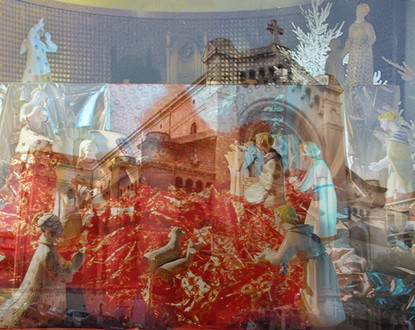This year, the Church of Saint Pierre d’Arène offers seven nativity scenes to parishioners and the public. We discover the traditional parish nativity scene with figurines created by Andrée Dienis, a ceramic artist and disciple of Matisse. It evolves and changes in design each year, magnificently reigning at the foot of the altar of the Virgin Mary.
We then descend the side nave to discover ‘O Presépio,’ a nativity scene from the Portuguese community, with figures heading toward the stable. Simple and rich in color, it evokes the mystery of Christmas with the birth of baby Jesus. Next, Father Scotto recalls the memories of the Pieds Noirs with a white-dominated nativity scene, representing purity, innocence, and Christmas.
Each of these three nativity scenes has its originality and remains within the realm of tradition. We will now discuss the other four nativity scenes, four visions of the Christmas message. First, there is the artist Moya’s creation, with tiny characters resembling Pinocchio nestled behind panels, climbing and seeking to discover the child born in a manger. The artist’s message is innocence. Then, the students, along with the chaplaincy and Father Christophe, deliver a message of peace, a word mentioned in several languages, highlighting countries at war and places where Christians are persecuted for their faith. Christmas is above all about peace, as declared by the large panels.
The children in catechism have also made their nativity scene, expressing innocence and hope in their own way, for they are the future, the tomorrows.
The last nativity scene, perhaps the most original, is made of beach pebbles and branches of wood. It is located at the feet of Saint Peter, the patron of this church. The message conveyed by its creators is one of charity, from the Poverello to Pope Francis. Thus, the three virtues: Hope with the students and catechism, Charity with the Pebbles, and Faith with all the nativity scenes, are represented.
Thierry Jan


